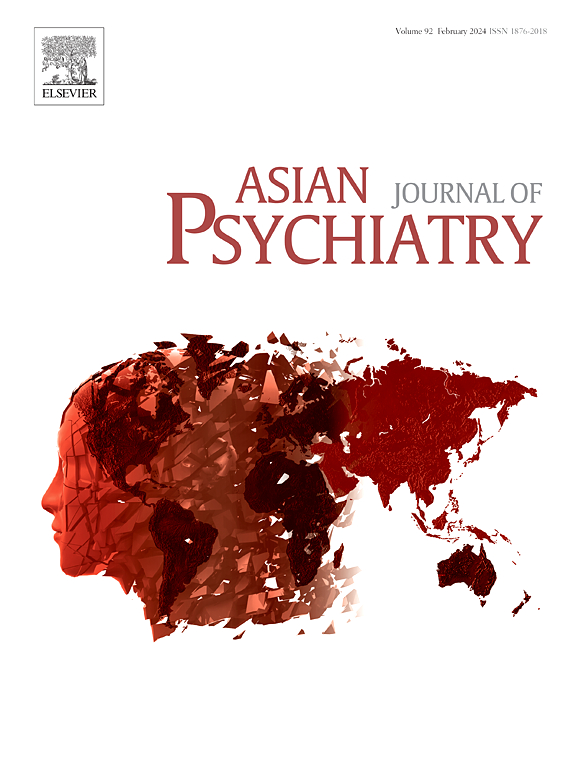为巴基斯坦儿童和青少年制定自杀筛查和预防指南:第一步
IF 4.5
4区 医学
Q1 PSYCHIATRY
引用次数: 0
摘要
本文的重点是由巴基斯坦精神病学研究中心的国家和国际专家工作队制定自杀筛查和预防指南,特别是针对巴基斯坦的儿童和青少年。讨论内容包括在医疗和非医疗环境中使用国际公认、有效和易于使用的筛查工具对青少年进行筛查。会议还提出建议,通过探索到2030年降低青年自杀率的重要后续步骤,超越巴基斯坦心理健康领域目前的模式。巴基斯坦估计有2.4亿人口,其中41%( %)的人口年龄在15岁以下。据信,大约35% %的巴基斯坦青年经历情感困难,压力、焦虑和抑郁是这一群体中最紧迫的问题。造成这些挑战的关键因素包括学业压力,社会和父母的期望加剧了学业压力,过度使用社交媒体,以及家庭动态,包括严格的教育,以及缺乏情感支持。现有的研究表明,15-18岁的巴基斯坦青少年自杀风险增加,其中摄入有毒物质是最常见的自杀方式,其次是上吊、跳到火车前和使用枪支。财政资源有限、缺乏训练有素的精神卫生专业人员以及社会污名等系统性障碍阻碍了进展。尽管如此,仍然存在大量的改进机会。提高公众对打击污名的认识、促进部门间合作和加强政策执行是必不可少的步骤。包括政策制定者、教育工作者、家庭和年轻人在内的多方利益攸关方方法对于建立可持续的精神卫生生态系统至关重要。本文章由计算机程序翻译,如有差异,请以英文原文为准。
Developing suicide screening and prevention guideline for the children and adolescents of Pakistan: The first step
This paper focuses on developing suicide screening and prevention guidelines by the Pakistan Psychiatric Research Center’s Task Force of national and international experts, specifically for children and adolescents in Pakistan. The discussion included screening for youth in medical and non-medical settings using internationally recognized, validated, and easy-to-use screening instruments. Recommendations were also made to advance beyond the current paradigm in Pakistan's mental health landscape by exploring essential next steps to reduce youth suicide rates by 2030. Pakistan has an estimated population of 240 million, with 41 % under the age of 15. It is believed that around 35 % of Pakistani youth experience emotional difficulties, with stress, anxiety, and depression being the most pressing concerns within this group. Key factors contributing to these challenges include academic pressure, intensified by societal and parental expectations, excessive social media use, as well as family dynamics, which encompass strict parenting, and a perceived lack of emotional support. Existing studies have identified an increased risk of suicide among Pakistani adolescents aged 15–18, with the ingestion of poisonous substances as the most common method, followed by hanging, jumping in front of trains, and firearm use. Systemic barriers, including limited financial resources, a shortage of trained mental health professionals, and societal stigma, impede progress. Nevertheless, ample opportunities for improvement exist. Raising public awareness to combat stigma, promoting inter-sectoral collaboration, and enhancing policy implementation are essential steps. A multi-stakeholder approach that includes policymakers, educators, families, and young people is crucial for building a sustainable mental health ecosystem.
求助全文
通过发布文献求助,成功后即可免费获取论文全文。
去求助
来源期刊

Asian journal of psychiatry
Medicine-Psychiatry and Mental Health
CiteScore
12.70
自引率
5.30%
发文量
297
审稿时长
35 days
期刊介绍:
The Asian Journal of Psychiatry serves as a comprehensive resource for psychiatrists, mental health clinicians, neurologists, physicians, mental health students, and policymakers. Its goal is to facilitate the exchange of research findings and clinical practices between Asia and the global community. The journal focuses on psychiatric research relevant to Asia, covering preclinical, clinical, service system, and policy development topics. It also highlights the socio-cultural diversity of the region in relation to mental health.
 求助内容:
求助内容: 应助结果提醒方式:
应助结果提醒方式:


